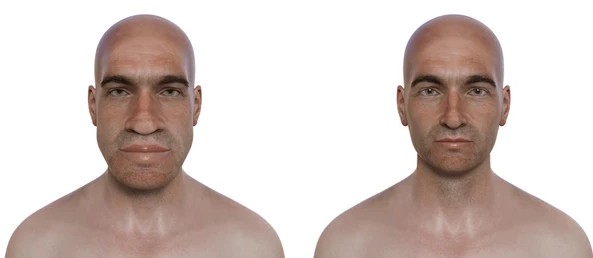What is Acromegaly?
Acromegaly is a rare hormonal disorder caused by the excessive production of growth hormone (GH), usually due to a pituitary gland tumor (adenoma). This leads to abnormal growth of bones and tissues, especially in the hands, feet, and face. If left untreated, acromegaly can result in serious complications, including heart disease, diabetes, and joint problems.

What Causes Acromegaly?
The condition is primarily caused by excess growth hormone (GH) production, which stimulates the liver to release insulin-like growth factor-1 (IGF-1), leading to abnormal tissue growth.
Common Causes of Excess Growth Hormone:
- Pituitary Adenoma (Most Common Cause)
- Benign tumor in the pituitary gland that overproduces GH
- Non-Pituitary Tumors (Rare Cases)
- Lung, pancreatic, or adrenal tumors that produce GH or GH-releasing hormone (GHRH)
What Are the Symptoms of Acromegaly?
Acromegaly develops slowly over many years, making it difficult to diagnose early. Symptoms vary depending on GH levels and disease progression.
Common Signs & Symptoms:
- Enlarged hands and feet (rings and shoes no longer fit)
- Facial changes – Enlarged jaw, nose, lips, and forehead
- Thickened skin and deepened voice
- Excessive sweating and body odor
- Joint pain, swelling, and arthritis
- Carpal tunnel syndrome (tingling in hands and fingers)
- Widened spaces between teeth (due to jaw growth)
- Sleep apnea (breathing pauses during sleep)
- Fatigue, headaches, and vision problems (due to tumor pressure on the brain)
- Enlarged organs (heart, liver, kidneys) leading to complications

How is Acromegaly Diagnosed?
Because symptoms develop gradually, early diagnosis is often challenging.
Diagnostic Tests:
- Blood Tests
- IGF-1 Test – High IGF-1 levels confirm excess growth hormone activity
- Growth Hormone Suppression Test – Measures GH levels after glucose intake (GH should normally drop, but in acromegaly, it remains high)
- Imaging Tests
- MRI or CT Scan – Detects pituitary tumors or other growth hormone-producing tumors
- Visual Field Test
- Checks for vision loss caused by pituitary tumor pressure on the optic nerve
What Are the Treatment Options for Acromegaly?
Treatment focuses on reducing growth hormone levels, managing symptoms, and preventing complications.
1. Surgery (First-Line Treatment)
- Transsphenoidal Surgery – Removes the pituitary tumor through the nose
- Effective in most cases, especially if the tumor is small
2. Medications (For Unresectable Tumors or Persistent GH Excess)
- Somatostatin Analogues (Octreotide, Lanreotide, Pasireotide) – Reduce GH production
- Growth Hormone Receptor Antagonists (Pegvisomant) – Blocks GH effects in the body
- Dopamine Agonists (Cabergoline, Bromocriptine) – Lowers GH levels in mild cases
3. Radiation Therapy (For Unsuccessful Surgery or Medication Resistance)
- Stereotactic Radiosurgery (Gamma Knife) – Directly targets the tumor
- Conventional Radiation Therapy – Slower effect but useful for tumor control
Can Acromegaly Cause Complications?
Without treatment, acromegaly can lead to serious health problems, including:
- Heart disease (hypertension, cardiomyopathy, heart failure)
- Diabetes due to insulin resistance
- Osteoarthritis and joint deformities
- Colon polyps (increasing risk of colorectal cancer)
- Enlarged internal organs (leading to respiratory issues)


